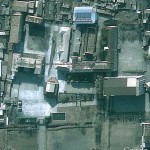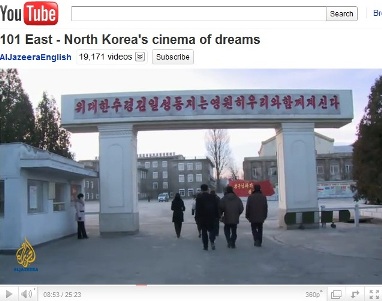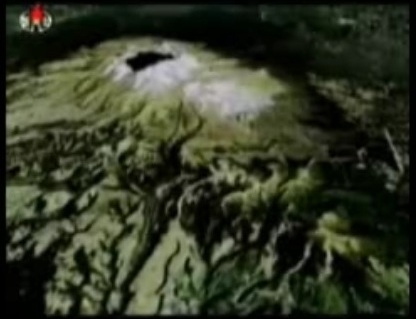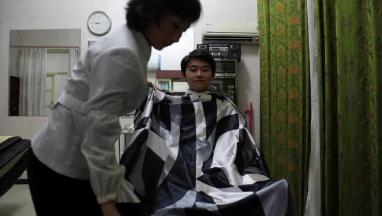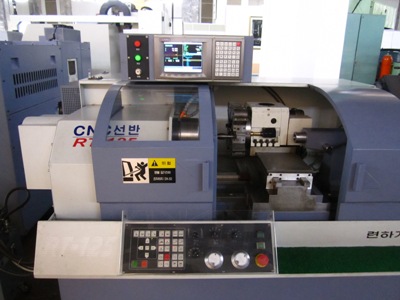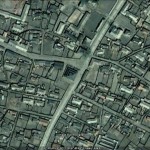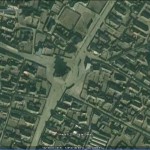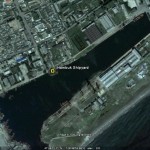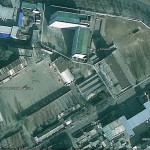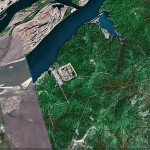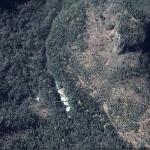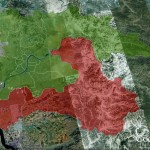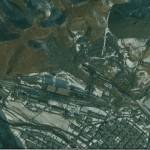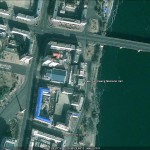Punjiman Tideland
In November of last year, the North Koreans announced that they had dammed up the Punjiman Tideland (bay) in Ongjin County to expand the quantity of arable land, build fish farms, and extract sea salt. Here is a picture of the project on from DPRK television:
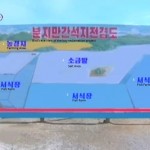
Thanks to a friend for translation help.
According to KCNA:
November 9 (KCNA) –The project for reclaiming Punjiman Tideland in Ongjin County of South Hwanghae Province was completed.
The reclaimed tideland is the country’s another asset of eternal value created in its western coastal area thanks to President Kim Il Sung’s great idea of remaking the nature and under the wise leadership of Kim Jong Il.
The reclamation of hundreds of hectares of tideland will help achieve an advance in the nation’s agricultural development and the improvement of the standard of people’s living.
A ceremony for its completion took place on Nov. 9.
KCNA does not offer much information on the project. Here is a rough sketch of the project on Google Earth:
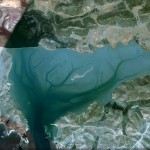
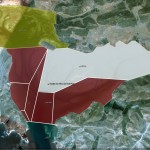
Before on top. After on bottom.
The area in yellow represents expanded farm land. The area in red represents new fish farms. The area in white represents a new salt farm.
According to Google Earth the width of the bay (east-west) is approximately 3.74km (2.33 miles). The bay is 1.98km (1.23 miles) tall (North South)–so appx. 3.7 sq km. I did not grow up in the agriculture business, so I have no idea what the project is capable of producing. If any readers are qualified to make those calculations, I would be happy to hear them.
Chongdan County Land Reclamation
On December 28, 2010, the DPRK held a ground breaking ceremony for the Ryongmae Island (룡매도) land reclamation project on the coast of Chongdan County in the Haeju Bay. The scale of the project is enormous. The surface area of the reclamation project is larger than the city of Haeju. Below are pictures from North Korean television and Google Earth:
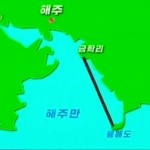
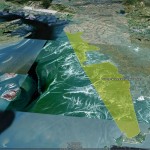
There is not much information on this project in KCNA either. From Top to bottom, the project is nearly 20km (12 miles) long. Although the groundbreaking was in December, the project has been in the works for some time. Development of the project was first announced in 1998. The Project is supposed to be completed by 2012. According to KCNA:
Pyongyang, July 10 (KCNA) — More than 26,600 hectares have been reclaimed from the sea on the western coast and are now ready for agriculture. This was the result of a nationwide win-soil-from-the-sea campaign launched a decade ago to gain additional agricultural land. From Pidan island at the northwestern tip of Korea at the mouth of Amnok River to the middle of west coast Rimhan-ri of Phanmun county sea walls have been erected to bring tidal flats into active agricultural use and thus create new highly intensive granaries. More than 100 islands and islets have been linked with the mainland to reduce the length of coastline by more than 500 kilometres, thus pushing the coastline 12 kilometres offshore. In the newly-reclaimed land, dozens of reservoirs and many salterns, fish-culture ponds and chemical-fibre producing centres, as well as the state and cooperative farms and workteams, have come into being. The drive to reclaim tidal flats, initiated by the DPRK government and the Workers’ Party of Korea, reached a high-water mark in the 1980s. More and more sea walls were erected to link one peninsula with another and islands with the mainland. To take a few examples, a dozens-of-kilometre-long dike connecting the Tasa islet in Yomju county and Rihwa-ri, Cholsan county to create a new granary of 8,800 hectares, Taegye islet, 68-km long dikes across the sea off Haeju connecting Kumhak, Chongdan county and Ryongmae islet to create new areas of agricultural use covering 2,500 hectares, 5,200 hectares in Kangryong, 3,300 hectares in Kumsong, 3,200 hectares in Unryul, 2,600 hectares in Kwaksan and 1,000 hectares in Chongsu islet. The lands thus won from the sea are equivalent to the total arable land of five counties.
UPDATE 1: According to KCNA (2011-8-13):
A tideland reclamation project has made progress around Rongmae Islet, opposite to the Haeju Bay on the south coast. The islet belongs to South Hwanghae Province.
Since the project was launched in January, the South Hwanghae Provincial Tideland Reclamation Complex moved about 250 000 cubic meters of earth and laid some 76 000 square meters of stones to build up a 2 100 meter-long embankment on the sea.
It was very cold when the project started. But the complex pushed ahead with it, overcoming difficulties.
It has also applied new reclamation methods suitable to geographical condition of the area.
Recent heavy rainfalls severed roads and bridges there. The builders are working on rebuilding them, while carrying on the project as scheduled through tunneling and blasting.
When the project is finished, a new arable land as large as that of a county will appear on the tideland.
UPDATE 2: According to KCNA (2011-8-15), the DPRK claimed that it did not fire on South Korea but was detonating explosives for this project.
